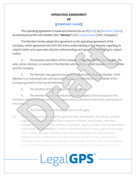Professional Services Agreements: Unlocking the Basics for Your Business
When it comes to the business world, nothing can quite replicate the satisfaction of a successful collaboration. However, success doesn’t just...
7 min read
LegalGPS : Oct. 7, 2024
When running a business, there's a good chance you'll need to enter into contracts with service providers, contractors, or consultants. In these cases, a well-crafted service agreement is essential. It outlines the terms of the deal and helps prevent misunderstandings, protecting both parties from potential legal disputes.


Service Agreement Template
Download our general Service Agreement Template to streamline client onboarding and protect your services with clear terms.
Trusted by 1,000+ businesses to safeguard their LLCs.
In this friendly and approachable guide, you'll learn all about service agreements and how to create the perfect template that covers all your needs. Let's dive right in and explore the world of service agreements!
A service agreement, sometimes referred to as a "general services agreement" or "consulting agreement," serves as the bedrock for business relationships between service providers and clients. It lays the groundwork for successful collaboration by defining the scope of services, payment terms, dispute resolution procedures, and much more.
Creating a service agreement template ensures that the essential legal terms are included, saving you time and reducing the risk of costly disputes down the road. So, what does a service agreement template look like, and how can you create your own? Let's find out!
Creating a service agreement may seem daunting, but breaking it down into essential elements can simplify the process. In this friendly and approachable guide, you'll learn about the critical elements of a service agreement template with a focus on making it actionable. Grab your favorite coffee, and let's get started!
Start by listing the full legal names and contact information (including mailing addresses, phone numbers, and email addresses) of both the service provider and the client. Be sure to indicate each party's status as an individual, sole proprietorship, corporation, partnership, or other legal entity.
Action Steps:
Specify your legal business name as the service provider
Get the same information for the client party
Include each party's contact information
Ensure you and your client are on the same page by detailing the services you'll be providing or receiving. List the specific tasks and responsibilities, along with the expected outcomes or deliverables (such as reports or finished products). Add any quality standards or performance metrics that must be met.
Action Steps:
Break down services into separate items or bullet points
Define expected deliverables and deadlines for each
Include any specific quality or performance requirements
Clearly define the payment structure, including the total amount due, payment schedule (one-time, installments, or milestone-based), payment method (checks, credit card, electronic transfer), and invoicing procedures. If applicable, state the terms for reimbursing any out-of-pocket expenses.
Action Steps:
Outline the total compensation for the services provided
Set a clear payment schedule with specified dates or milestones
Specify the payment methods you accept
Include any reimbursement procedures for expenses
Determine the duration of your service agreement by specifying a start and end date, or by identifying key milestones that signal the completion of the agreement. Address renewal options (automatic or manual) and how they can be exercised.
Action Steps:
Choose a specific start and end date or describe the completion milestones
Define renewal or extension options, if applicable
Establish the process for renewing or extending the agreement
Both parties must understand the procedures and grounds for terminating the agreement. List the specific conditions for termination and the required notice period (usually in days or weeks) for each.
Action Steps:
Identify circumstances under which the agreement can be terminated (e.g., material breach, non-payment)
Define the notice period required for termination
Explain the process for providing termination notice (e.g., email, certified mail)
Confidentiality and non-disclosure clauses help protect sensitive information. Clearly identify the types of information that are considered confidential, how the information should be protected, and how long those obligations last after the contract ends.
Action Steps:
List examples of confidential information (e.g., trade secrets, customer lists, pricing data)
Describe the responsibilities for protecting and not disclosing confidential information
State the duration of confidentiality obligations (e.g., 2 years after the agreement ends)
Comprehensive Service Agreements Guide
Decide on a method for resolving disputes between you and the client (e.g., negotiation, mediation, arbitration, litigation) and detail the procedure. Make sure to specify the governing jurisdiction (e.g., state or country) for any legal matters.
Action Steps:
Choose a preferred dispute resolution method (e.g., arbitration)
Outline the steps involved in the chosen dispute resolution process
Specify the governing jurisdiction (e.g., laws of the State of California)
Include statements that confirm the service provider's qualifications and commitment to high-quality services. List any guarantees or assurances made, along with any limits on liability (e.g., a cap on damages, disclaimers for incidental damages).
Action Steps:
State the service provider's qualifications, credentials, or licenses
Include a statement of commitment to industry standards and quality
Limits on liability (e.g., a cap on claim amounts, disclaimers for specific damages)
Now that you know the essential elements, let's move on to the step-by-step guide to creating your service agreement template!
Get Your Service Agreement Template
with a Legal GPS Subscription
Begin by clearly identifying the parties involved in the contract. This section should include:
The legal names of both the service provider and the client
Their business addresses and contact information
You may also want to include each party's status as a sole proprietor, corporation, or other legal entity type.
This section explains in detail the services the provider will perform for the client. Be as specific and precise as possible to avoid misunderstandings later. For example:
A detailed list of tasks the service provider will perform
Expected deliverables and their deadlines
Any relevant specifications, guidelines, or performance standards
You can choose to attach a separate document detailing the scope of services, such as a project proposal or statement of work, and reference it in the agreement.


Legal GPS Pro
Protect your business with our complete legal subscription service, designed by top startup attorneys.
Next, outline the financial aspects of the agreement, including:
The total amount payable for the services
The payment schedule (e.g., in installments or upon completion of milestones)
Acceptable forms of payment (e.g., check, credit card, or electronic transfer)
Any penalties for late payments or provisions for early payment discounts
Be sure to include details on reimbursable expenses, such as travel costs or supplies that the service provider may incur while performing the services.
Specify the length of the service agreement, which may be a fixed period or determined by the completion of certain tasks. This section should include:
Start and end dates, or a clear indication of how the agreement's duration will be determined
Any options for renewal or extension, and how these can be exercised
The process for early termination, such as required notice periods and possible grounds for termination (e.g., material breach or failure to perform)
It's crucial to protect sensitive information, including trade secrets, customer lists, and proprietary technology. These clauses should cover:
The types of information considered confidential
The duties of each party to protect and not disclose confidential information
The allowable uses of the confidential information
How long the confidentiality obligations last, even after the termination of the agreement
Include a section outlining how disputes between the parties will be resolved. This may involve negotiation, mediation, arbitration, or litigation. Be sure to specify:
The process for initiating dispute resolution (e.g., written notice)
The timeframe for each stage of the dispute resolution
The jurisdiction under which disputes will be resolved, such as a specific state or country
This section outlines any guarantees or assertions made by the service provider about their services. It may include:
The service provider's qualifications, skills, and licenses
A statement that the services will be performed in a professional manner, in accordance with applicable industry standards
Limitations on liability for the service provider's actions under the agreement (e.g., a cap on damages or a disclaimer of consequential and incidental damages)
Once you've gone through these steps and drafted your template, it's time to finalize the document. Leave space for both parties to sign and date the agreement. You may also want to include a provision for any amendments to the agreement, such as requiring them to be in writing and signed by both parties.
Now that you have a solid template, it's essential to customize it based on the specific service you're offering or receiving. This may involve adding or adjusting:
Payment milestones based on unique project requirements
Any additional services or deliverables not covered by the initial scope
Additional warranties or representations unique to your industry or service offering
By tailoring the template, you can ensure it addresses the unique needs of your specific project.

Service Agreement Template
Download our general Service Agreement Template to streamline client onboarding and protect your services with clear terms.
Trusted by 1,000+ businesses to safeguard their LLCs.
Creating a perfect service agreement template is a crucial step in avoiding potential disputes. Here are some common mistakes to avoid:
Vague or poorly defined scope of services
Inadequate payment terms, leading to billing disputes
Failing to address intellectual property rights
Not keeping a signed copy of the agreement on file
By following this guide, you'll minimize these risks and create a service agreement template that protects your business interests.
A well-crafted service agreement template is a vital tool for ensuring a smooth and successful business relationship. By following this step-by-step guide, you'll be well on your way to creating a robust and adaptable service agreement template that meets the needs of your service provider or client.
You can also consider purchasing a professionally designed service agreement template from our website. This option guarantees high-quality language, expertly crafted clauses, and peace of mind knowing your agreement complies with industry standards and best practices.
Regardless of which path you choose, a comprehensive service agreement template is an investment in the long-term success of your business relationships.
The biggest question now is, "Do I need a business lawyer?” For most businesses and in most cases, you don't need a lawyer to start your business. Instead, many business owners rely on Legal GPS Pro to help with legal issues.
Legal GPS Pro is your All-In-One Legal Toolkit for Businesses. Developed by top startup attorneys, Pro gives you access to 100+ expertly crafted templates including operating agreements, NDAs, and service agreements, and an interactive platform. All designed to protect your company and set it up for lasting success.
Get Legal GPS's Service Agreement Template Now

Legal GPS Pro
Protect your business with our complete legal subscription service, designed by top startup attorneys.
|
Premium Template
Single-use Template |
Legal GPS Pro
Unlimited Access, Best Value |
|
|
| Choose Template | Learn More |
| Trusted by 1000+ businesses | |

When it comes to the business world, nothing can quite replicate the satisfaction of a successful collaboration. However, success doesn’t just...

Welcome, entrepreneur friend! In today's world, referrals are becoming even more essential for businesses to expand their client base and increase...

Running a sustainable consulting or coaching business means dealing with multiple moving parts. One key aspect of this infrastructure that often...